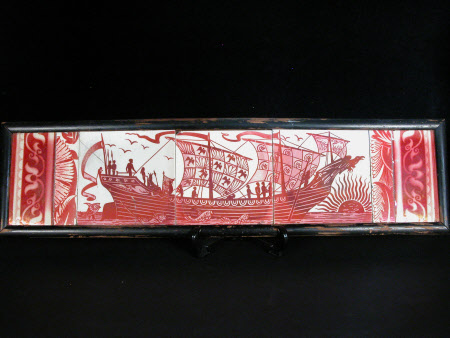Tile panel
William Frend De Morgan (London 1839 - London 1917)
Category
Ceramics
Date
1875 - 1900
Materials
Pottery
Measurements
180 mm (H); 690 mm (L)
Place of origin
England
Order this imageCollection
Wightwick Manor, West Midlands
NT 1287476
Caption
The theme of the sea was a major source of inspiration for William De Morgan, with galleons being one of his favourite motifs. This tile set also features some of De Morgan’s animals; the almost mythical, aggressive birds alongside the playful, unintelligent-looking fish. On the deck of the ship, the silhouette of a king can be seen being entertained by a harpist.
Summary
Tile panel - Rectangular panel of red lustre de Morgan tiles. Painted with galleon in full sail, its crew on deck. Sun rising on right. Flanked by two examples of co-ordinating border tiles. Contained in black wood frame.
Full description
William Frend De Morgan (1839 – 1917) was one of the most important potters of the late nineteenth century, an innovator in both design and technique. His wide range of design sources is matched by his interest in different potting and glazing techniques. This set of seven red lustre tiles are decorated with a galleon in full sail with its crew visible on deck. The rising Sun can be seen on the right hand side and on each end are two examples of co-ordinating boarder tiles. The theme of the sea was a major source of inspiration for De Morgan’s Arts and Crafts ceramics and his wife Evelyn’s paintings. Galleons were one of De Morgan’s favourite motifs, developing eighteen distinct designs. The design of the ships were inspired by Medieval and Tudor ships shown in manuscript illustrations such as those carrying the hero’s of Morte d’Arthur, or the warring kings of Froissant. De Morgan’s galleon designs are distinctive for their use of stylised waves, giant fish, dolphins and sea monsters. These are ships of the imagination and are often in full sail with overstated flags and banners, being of a more decorative nature rather than sea-worthy. Often, silhouettes of passengers can be seen on deck; here a king can be seen on deck being entertained by a harpist. Other galleon designs feature the passenger as Sinbad aiming his bow and arrow at a giant Roc flying overhead. These are ships of the imagination and are often in full sail with overstated flags and banners, being of a more decorative nature rather than sea-worthy. Many of his animals are depicted as aggressive and can be seen attacking other animals, but in contrast De Morgan’s fish are self consciously decorative and do not look very intelligent. The fish design proved very useful to De Morgan as he adapted them into linear designs by turning the fish into a serpentine shape, exaggerating the fins so that they almost became wings. In this set of tiles the fish can be seen to swim playfully alongside the ship, whereas the birds featured on the sails and on the prow are of a more hostile design. Though De Morgan’s business was not financially a success, the tiles that he produced were much appreciated in the nineteenth century and appeal today to a growing group of collectors and ceramic experts.
Makers and roles
William Frend De Morgan (London 1839 - London 1917), maker
